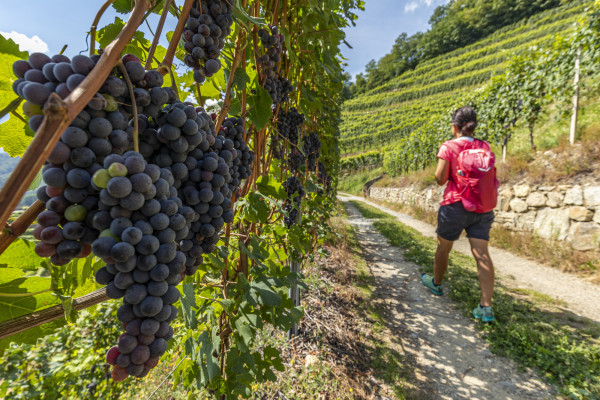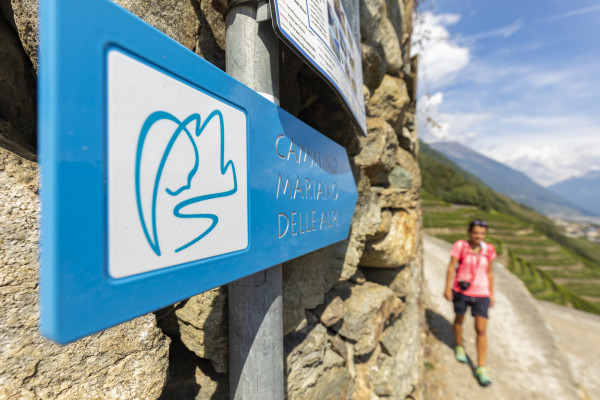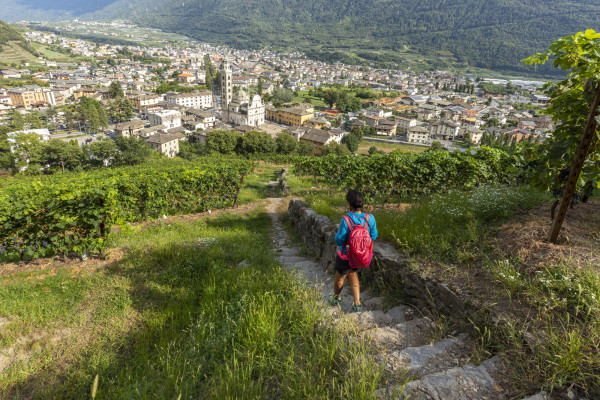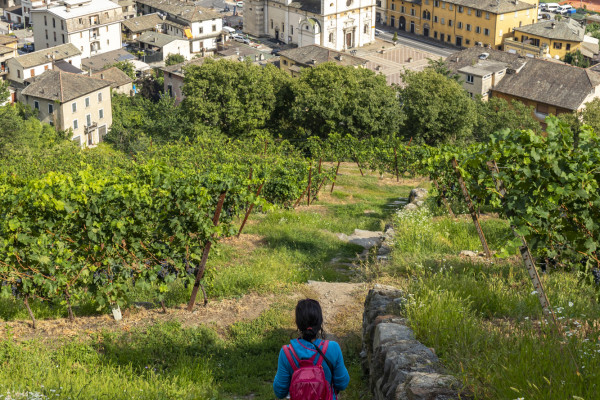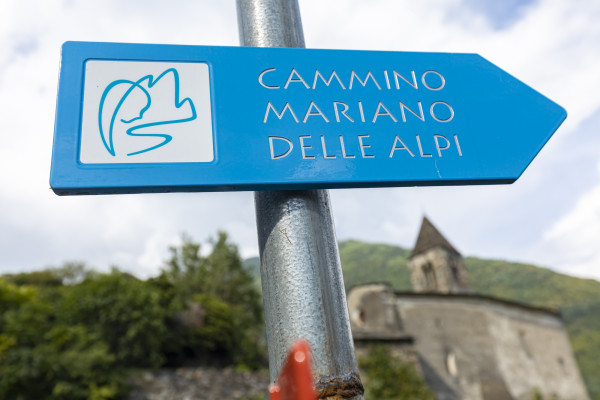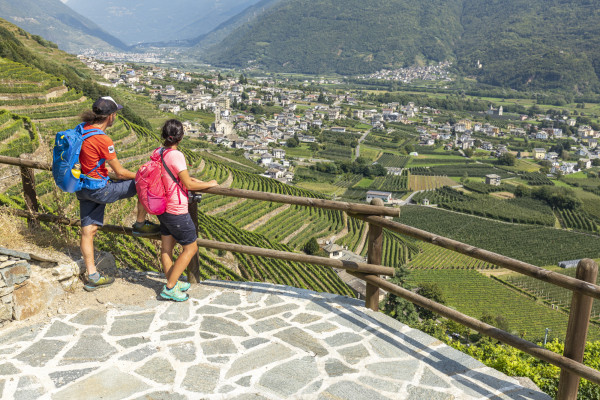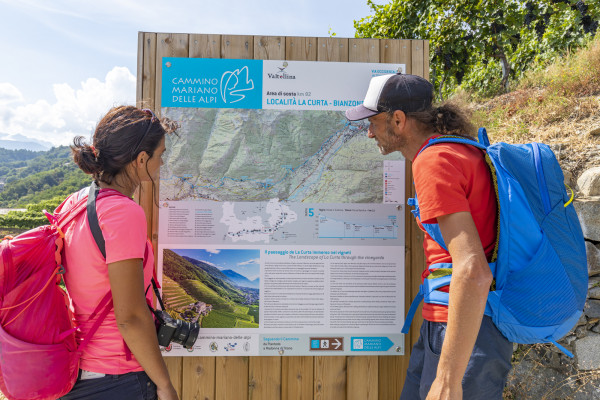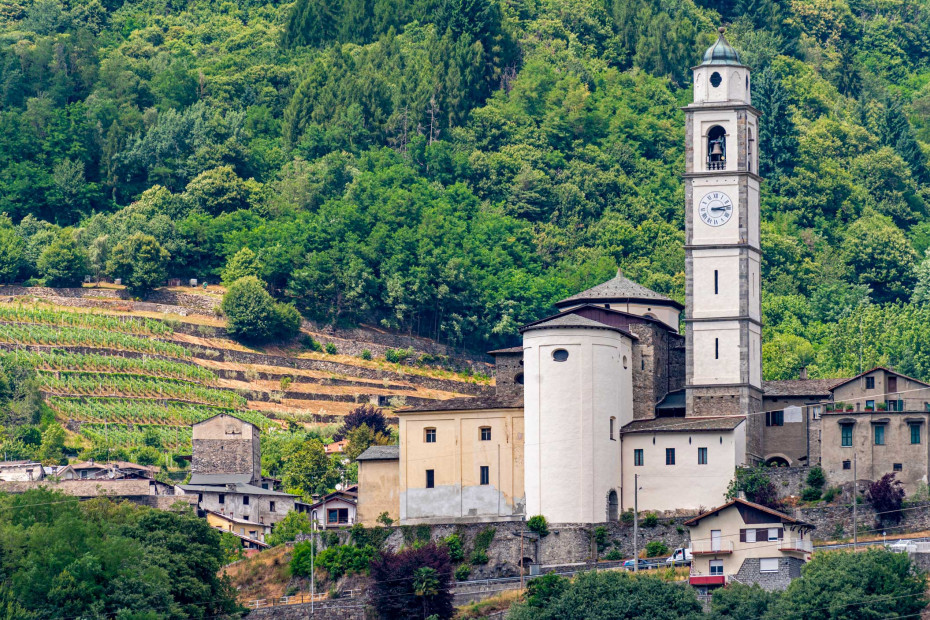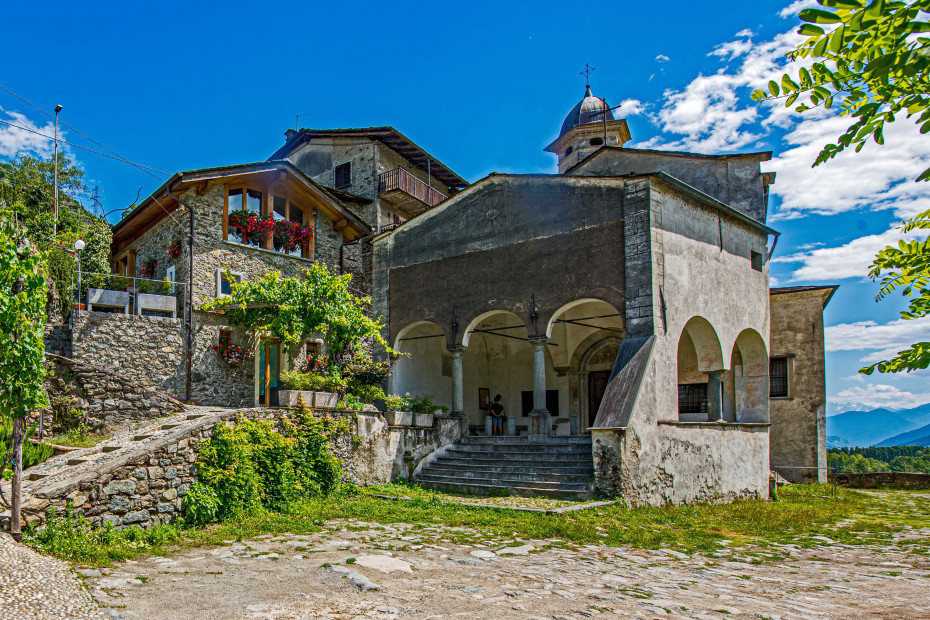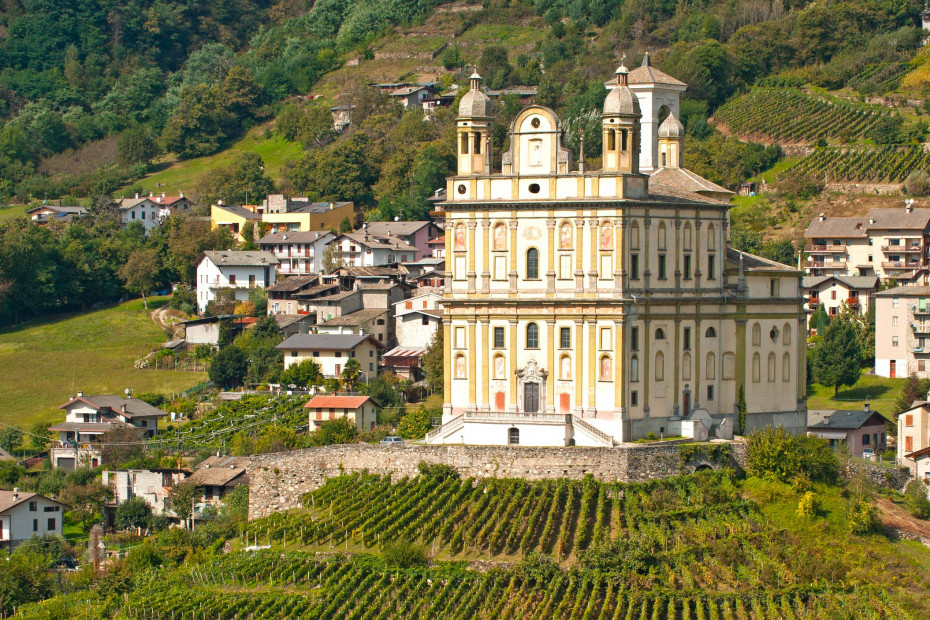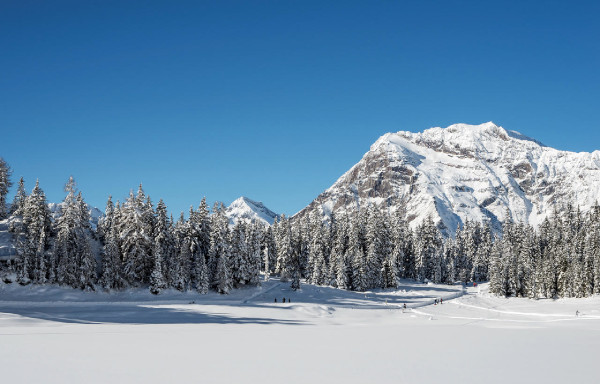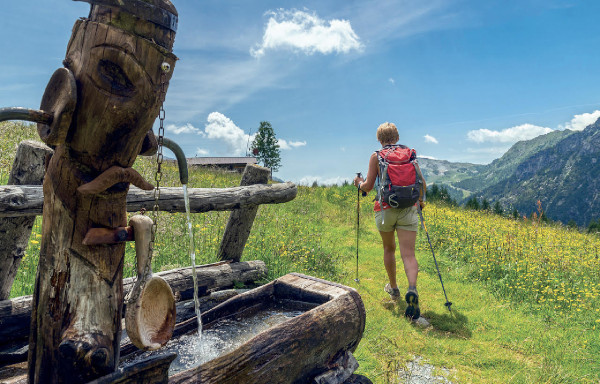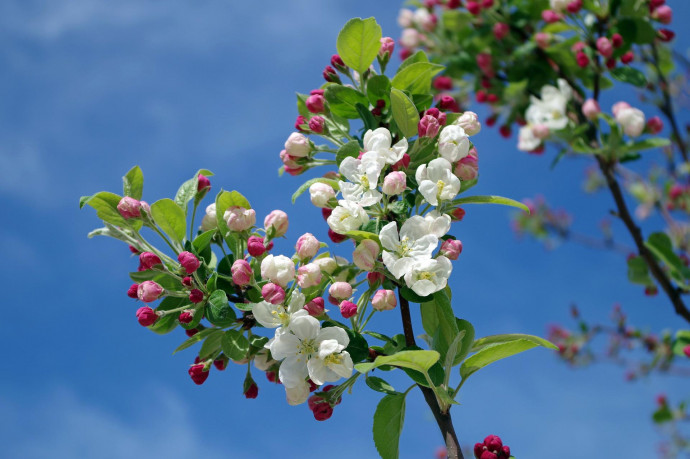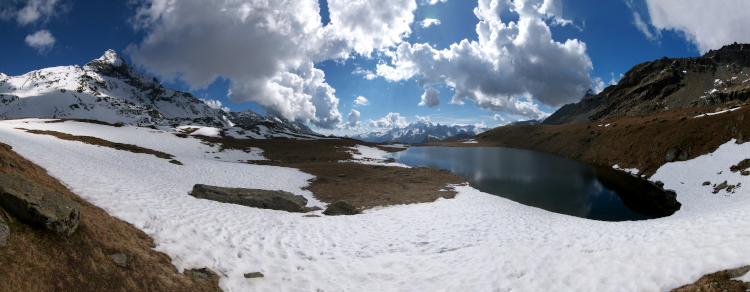- Religious Tourism
Cammino Mariano delle Alpi
The Cammino mariano delle Alpi pilgrimage route is an important religious, cultural and tourism-driven project in Valtellina. Tracing a route through the valley, the hiking itinerary incorporates several shrines to the Virgin Mary before reaching the Basilica of the Madonna di Tirano — the most significant sacred monument in the province and proclaimed the ‘celestial patroness of all of Valtellina’ by Pope Pius XII in 1946.
There are two route options: the 91km Via Occidentale (western approach) from Piantedo to Tirano (accessible from spring 2022) and the 66km Via Orientale (eastern approach) from Bormio to Tirano, in the planning stage.
The Via Occidentale is divided into five stages: Piantedo–Morbegno, Morbegno–Berbenno, Berbenno–Sondrio, Sondrio–Teglio and Teglio–Tirano. It makes use of the existing trail network and waymarked routes, including the Via dei Terrazzamenti which traverses the valley’s most authentic and charming areas, passing distinctive terraced vineyards and a wealth of historic, religious and civic buildings that transmit a fascinating insight.
Discover more and request the Credenziale del pellegrino on www.camminomarianodellealpi.it
Mostra cosa c'è nelle vicinanze:
Itinerary stages
Stage 2 - Morbegno - Berbenno
This long stage begins in the bottom of the valley before climbing onto the slopes of the Rhaetian Alps to reach Berbenno di Valtellina and the Church of Santa Maria Assunta. Sat on the sunny, south-facing slopes, the view opens up, letting you admire the valley’s terraced vineyards, and incorporates stretches of the Via dei Terrazzamenti walking trail.
Departing from Morbegno, this is one of the longest stages of the western approach to the Cammino mariano delle Alpi. On the edge of the town stands the shrine of the Beata Vergine, a stunning example of Lombard and Valtellina-style renaissance architecture. After a stretch on the Orobic Alps side of the valley, passing Talamona with its parish Church of the Natività di Maria Vergine, the route crosses over the River Adda and begins to climb through the distinctive terraced vineyards on the Rhaetian Alps side of the valley. There are two churches sharing the same name in Paniga, the Church of the Madonna delle Grazie – the older one comes first, followed by the second, built at the end of the sixties and is now the heart of the village, slotting majestically into the landscape by blending tradition with modernity through its choice of material (stone) and form (note its sinuous lines and circular turret that stretches up).
The route now levels out until you begin the climb to Gaggio and the Church of the Beata Vergine del Buon Consiglio, built with the generous donation of a churchgoer who emigrated to Rome and decided to dedicate the church to the Madonna del Buon Consiglio, as this version of Mary was spreading in popularity from Rome and out across Italy.
Three kilometres further on, you reach Buglio in Monte and the parish Church of San Fedele, built with the typically sober style of Valtellina’s baroque architecture. After eight kilometres, you reach the end of the second stage—the Church of the Beata Vergine Assunta in Berbenno with its early 18th-century wooden entrance, one of the most beautiful in the valley.
While arguably a long stretch, you’ll be richly rewarded by the scenery as you stroll through the valley’s signature terraced vineyards and the holy buildings along the route.
Stage 3 - Berbenno - Sondrio
Sticking to the Rhaetian Alps side of the valley, leave Berbenno di Valtellina and its church and head towards the beautiful site of the Santuario della Madonna della Sassella, tucked into the vineyards where it has sat for centuries.
Take a look inside before dropping down into Sondrio, the main town of the province. From Sassella to Tirano, the landscape is unique, shaped by steep vineyards and dry-stone walls—the art of which has been recognized by UNESCO and added to its list of Intangible Cultural Heritage of Humanity.
From the Church of the Beata Vergine Assunta in Berbenno, head through the valley’s distinctive terraced vineyards towards Sondrio, noting their characteristic dry-stone walls, which have been declared a UNESCO Intangible Cultural Heritage of Humanity.
After ten kilometres, you’ll reach the stunning Sanctuary of the Santa Maria della Sassella, perched on a rocky cliff above a bend in the River Adda at the entrance to Sondrio, where it’s surrounded by grape vines and rocks on the ancient Via Valeriana.
Next up is Sondrio, a small city that is the capital of the province and easily explored on foot. The recently built Church of the Beata Vergine del Rosario is the final stop for stage three of the Via Occidentale.
Stage 4 - Sondrio - Teglio
In one of the most picturesque and panoramic stages, you will traverse the south-facing slopes through vineyards and ancient villages, stopping at several of the most fascinating churches, including the Church of Santa Maria di Ligone, thought to be amongst the oldest in Valtellina. The stage ends in Teglio, the valley’s former capital (and origin of its name), where you’ll find the ancient Church of Santa Eufemia.
One of the most picture-perfect, panoramic stretches of the Via Occidentale, the fourth stage stays on the Rhaetian Alps side of Valtellina, through vineyards, ancient villages and historic sites.
You’ll leave Sondrio through the fascinating old neighbourhood of Scarpatetti and climb to Castel Masegra and the village of Ponchiera. From here, the route heads along the terraces to Montagna in Valtellina (with the Church of the Madonnina and the Church of Madonna del Carmine) followed by Poggiridenti and the Church of the Beata Vergine del Buon Consiglio.
Three kilometres further on you’ll reach Tresivio, where one of the most significant religious buildings in the entire province stands: the stunning Sanctuary of the Santa Casa, which, thanks to its impressive profile, façade, and double order of regularly placed niches on the sides, is unlike any of the other baroque churches in Valtellina. Inside, the holy house of the Virgin (a temple inside the temple) and the wooden statue of the Madonna Nera replicate the layout of the celebrated Sanctuary of Loreto in Le Marche.
The stage continues with mesmerizing scenery, escorting you to Ponte in Valtellina, one of the most picturesque villages in Valtellina, and the Church of Beate Vergine del Buon Consiglio, which has such a plain aesthetic it’s easy to miss it amongst the houses. From here, the route begins to climb up to Teglio, another charming village and the birthplace of the local dish pizzoccheri. After passing the medieval Church of Santa Maria di Ligone – the site where local processions on Holy Mass occasions for the Madonna culminate – you’ll reach the ancient parish Church of Santa Eufemia, the stage’s final destination.
